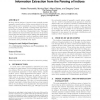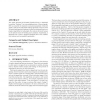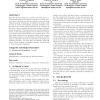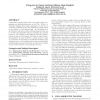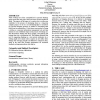HT
2009
ACM
14 years 6 months ago
2009
ACM
Modern critical editions of ancient works generally include manually created indices of other sources quoted in the text. Since indices can be considered as a form of domain speci...
HT
2009
ACM
14 years 6 months ago
2009
ACM
Web pages such as news and shopping sites often use modular layouts. When used effectively this practice allows authors to present clearly large amounts of information in a single...
HT
2009
ACM
14 years 6 months ago
2009
ACM
Folksonomies provide a rich source of data to study social patterns taking place on the World Wide Web. Here we study the temporal patterns of users’ tagging activity. We show t...
HT
2009
ACM
14 years 6 months ago
2009
ACM
This paper describes the Scalable Hyperlink Store, a distributed in-memory “database” for storing large portions of the web graph. SHS is an enabler for research on structural...
HT
2009
ACM
14 years 6 months ago
2009
ACM
HT
2009
ACM
14 years 6 months ago
2009
ACM
Narrative systems attempt to present users with media collections that include some element of structure or story, however these collections can lack an authorial voice and seem b...
HT
2009
ACM
14 years 6 months ago
2009
ACM
Sixearch.org is a peer application for social, distributed, adaptive Web search, which integrates the Sixearch.org protocol, a topical crawler, a document indexing system, a retri...
HT
2009
ACM
14 years 6 months ago
2009
ACM
The Web is a hypertextual environment in permanent evolution. There are new technologies and Web publishing behaviors emerging everyday. This study presents trends on the evolutio...
HT
2009
ACM
14 years 6 months ago
2009
ACM
Collaborative tagging systems are now popular tools for organising and sharing information on the Web. While collaborative tagging offers many advantages over the use of controll...
HT
2009
ACM
14 years 6 months ago
2009
ACM
While weblogs have been conceptualised as personal thinking spaces since their early days, those uses have not been studied in detail. The purpose of this paper is to explore how ...
